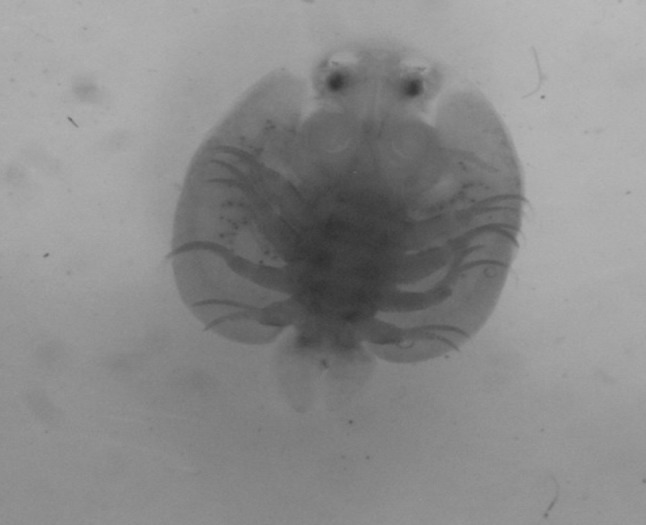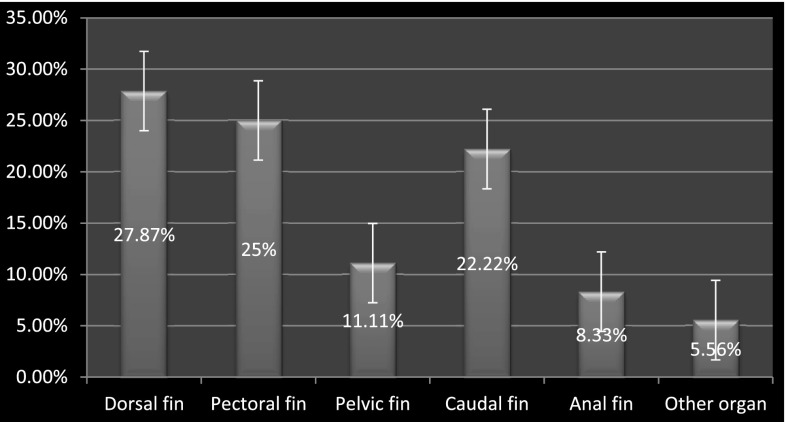Abstract
The genus Argulus (Crustacea: Branchiura), or fish louse, are common parasites of freshwater fish. This parasite have a direct life cycles and mature females leave the host and lay several hundred eggs on vegetation and various objects in the water. It caused pathological changes due to direct tissue damage and secondary infections. Besides the damage and stress caused by Argulus itself, one of the main worries for fish producers are the associated secondary infestations and infections that can result from infestation with this ecto-parasite. From 300 samples, only 20 (6.67 %) samples were infested with this parasite and 280 (93.33 %) not infested. In the present study, Argulus foliaceus was reported on goldfish and Koi which this was first recorded in Kerman, southeast of Iran. According to the presented study, it is clear that A. foliaceus can act as a potential risk factor for natural ecosystems and native fish population of Iran and other countries, that should be mentioned to prevent the burst of new parasitic fauna to Iran and different countries as well as stop direct economic losses caused by mortality derived from infestation with this ecto-parasite.
Keywords: Prevalence, Argulus foliaceus, Kerman, Iran
Introduction
The genus Argulus (Crustacea: Branchiura), or fish louse, are common parasites of freshwater fish (Klinger and Floyd 1998; Thilakaratne et al. 2003). Many of the species are parasitic on marine fishes, and about 15 spp. are found on freshwater fishes (Noaman et al. 2010), these parasites are 5–10 mm in size and consist of a head, thorax and abdomen the head is covered by a flattened horseshoe-shaped carapace, maxillipeds, peroral sting and basal glands (Soulsby 1982; Yildiz and Kumantas 2002). The thorax contains four segments that each segment taking a pair of swimming legs and the abdomen has a simple bilobed segment (Soulsby 1982; Yildiz and Kumantas 2002). Argulus foliaceus have a direct life cycles that due to not require to the intermediate hosts for complete its life cycle and transports quickly among the fishes (Al-Dulaimi 2010). In its life cycle, fertilized females depart the host and lay several hundred eggs on vegetation and various objects in the water. Eggs are protected by a gelatinous capsule and are ovoid in shape. 40–100 days are needed for completion of the life cycle and this time is depended on the environment temperature (Mikheev et al. 2001). Adults may live free from the host for up to 15 days. A. foliaceus is an obligatory blood sucker and can survive for only a few days without the host fish, depending on size and ambient temperature (Koyun 2011). This parasite infected the skin, fins and gills of the freshwater fishes hosts (Yildiz and Kumantas 2002). It caused pathological changes due to direct tissue damage and secondary infections (Al-Dulaimi 2010). It feeds by piercing the skin of the host, with heavy infestations leading to serious skin damage, stress and death (Harrison et al. 2006). Feeding can take place on the skin or in the gills of the fish causing intense irritation and tissue damage (Al-Dulaimi 2010). Besides the damage and stress caused by A. foliaceus itself, one of the main worries for fish Producers is the associated secondary infestation that can result from infestations with this ectoparasite (Noaman et al. 2010). Many researches have been done on prevalence of A. foliaceus but the reseaches on prevalence of this ectoparasite in Iran are scanty (Al-Dulaimi 2010; Buchmann and Bresciani 1997; Ebrahimzadeh Mousavi et al. 2011; Harrison et al. 2006; Noaman et al. 2010; Pazooki et al. 2007; Thilakaratne et al. 2003; Yildiz and Kumantas 2002). Therefore, this study was aimed to determine the prevalence A. foliaceus of ornamental fishes (Goldfish and Koi) of Kerman, southeast of Iran. This is the first research on prevalence of A. foliaceus in Kerman, southeast of Iran.
Materials and methods
Three hundred ornamental fish (200 pieces gold fish and 100 pieces Koi) from 10 pet fish supply store in the Kerman, southeast of Iran, in the winter 2013 were randomly selected. Then, the fish caught by hand tour and were transferred to plastic container containing water. Samples were examined macroscopically, microscopically, clinically for presence of A. foliaceus. In the macroscopic method, contaminated fishes were brought out and their parasites were removed with forceps from different parts of the body. By microscopic method, the fish were examined by dissecting microscope. Collected parasites were fixed in 70 % ethanol and transferred to laboratory of parasitology in the School of Veterinary Medicine, Shahid Bahonar University of Kerman. Then parasites were identified using the diagnostic key.
Results
The study demonstrated that only 20 out of those 300 samples were infested with A. foliaceus, meaning a 6.67 % prevalence. The highest infestation rate was in gold fish (9.5 %) and lowest in Koi fish (1 %) (Table 1). All collected parasite were A. foliaceus (Fig. 1).
Table 1.
Prevalence of A. foliaceus infection in two species of ornamental fish (Goldfish, Koi)
| Species fish | Number of studied fish | Number of infested fish | Prevalence (%) |
|---|---|---|---|
| Gold fish (Carassius auratus) | 200 | 19 | 9.5 |
| Koi (Cyprinus carpio) | 100 | 1 | 1 |
| Total | 300 | 20 | 6.67 |
Fig. 1.

Argulus foliaceus magnification (×4)
In this study, all fish had generalized symptoms including lack of appetite and abnormal swimming. Bloody spots were also observed on skin and fins. In the present study, The distribution of A. foliaceus contamination on different body regions was examined. Results showed that 10 (27.78 %) parasites were found on dorsal fins, 3 (8.33 %) on anal fins, 4 (11.11 %) on pelvic fins, 9 (25 %) on pectoral fins, 8 (22.22 %) on caudal fins and 2 (5.56 %) in other organs as mouth and gill (Fig. 2).
Fig. 2.
Distribution of A. foliaceus infection in fins and other organs of fish
Discussion
The propagating and rearing of ornamental fish have a remarkable situation in the World and plays a valuable role in exchange income of some countries and in Occupation. The world trade share of these fish which was estimated about 900 million dollar, has given an important insight into it (Meshgi et al. 2006). Because of the economic importance of these aquatics, many researchers have paid attention the different factors threatening their health. Gold fish is one of the main ornamental fish for which more than 100 varieties have been produced with selective hatching and many people are interested in their propagating and rearing. Besides their propagating in different fish farms in Iran, different species of goldfish are imported annually from Southeast Asian countries. Researches carried out on goldfish and Koi confirms the Argulus as the most prevalent parasite (Noga 2010). A few parasites species like protozoa are seemingly non-host specific species and have been found in a large-scale of fresh or brackish water fish species throughout the world. A. foliaceus were reported from different fish’s species worldwide and reported with some of the goldfish in Turkey Sarieyyupoglu and Saglam (Buchmann and Bresciani 1997). In the present study, A. foliaceus was reported on goldfish and Koi which this was first recorded in Kerman, southeast of Iran. The lice fish is a dangerous parasite lacking specificity, so that it can probably infested all freshwater fishes and occurring in estuarine or coastal and marine water habitats (OKtener et al. 2007). Al-Dulaimi (2010) in Babylon province of Iraq reported cases of the infection with A. foliaceus lice in different goldfish species in the earthen ponds (Al-Dulaimi 2010). Notash (2012) sudied on the goldfishes in east Azerbaijan province of Iran and reported that they were infested with at least one species of crustacean (Notash 2012). Also Ebrahimzadeh Mousavi et al. (2011) studied on the 10 different ornamental fishes farm in Iran and reported that 230 pieces of the goldfishes were infested with three species of this ectoparasite (Ebrahimzadeh Mousavi et al. 2011). In this research, it was observed that infected fishes have generalized symptoms including lack of appetite and abnormal swimming and blood points were also observed on the skin and fins. Also sometimes opportunistic bacteria had infected these damaged areas leading to skin ulcer. According to our results, the mean number of A. foliaceous from each infested goldfish was 1–3, while Yildiz and Kumantas (2002) and Noaman et al. (2010) reported the isolation of at least 3 ectoparasites on infested goldfish. This difference can be relevant to the stages of infestation, related to the early stage of infestation and life cycle of the ectoparasite (Noaman et al. 2010; Yildiz and Kumantas 2002). In the present study, A. foliaceus was reported on goldfish and Koi which this was first recorded in Kerman, southeast of Iran. According to the presented study, it is clear that A. foliaceus can act as a potential risk factor for natural ecosystems and native fish population of Iran and other countries, that should be mentioned to prevent the burst of new parasitic fauna to Iran and different countries as well as stop direct economic losses caused by mortality derived from infestation with this ecto-parasite.
References
- Al-Dulaimi FHA. Infection with a fish louse Argulus foliaceus L. in a gold fish (Carassius auratus) at Earthen Ponds and Aquarium Fish in Babylon Province, Iraq. J Babylon Univ Pure Appl Sci. 2010;18:468–473. [Google Scholar]
- Buchmann K, Bresciani J. Parasitic infections in pond-reared rainbow trout oncorhynchus mykiss in Denmark. Dis Aquat Organ. 1997;28:125–138. doi: 10.3354/dao028125. [DOI] [Google Scholar]
- Ebrahimzadeh Mousavi H, Behtash F, Rostami-Bashman M, Mirzargar S, Shayan P, Rahmati-Holasoo H. Study of Argulus spp. infection rate in goldfish carassius auratus (Limmaeus 1758) in Iran. HVM bioflux. 2011;3:198–204. [Google Scholar]
- Harrison A, Gault N, Dick J. Seasonal and vertical patterns of egg-laying by the freshwater fish louse Argulus foliaceus (Crustacea: Branchiura) Dis Aquat Organ. 2006;68:167–173. doi: 10.3354/dao068167. [DOI] [PubMed] [Google Scholar]
- Klinger RE, Floyd RF. Introduction to freshwater fish parasites. Gainesville: University of Florida Cooperative Extension Service, Institute of Food and Agriculture Sciences, EDIS; 1998. [Google Scholar]
- Koyun M. The effect of water temperature on Argulus foliaceus L. 1758 (Crustacea; Branchiura) on different fish species. Notulae Scientia Biologicae. 2011;3:16–19. [Google Scholar]
- Meshgi B, Eslami A, Yazdani H. Study on the parasitic infections of aquarium fishes around Tehran. J Vet Res. 2006;61:1. [Google Scholar]
- Mikheev VN, Pasternak AF, Valtonen ET, Lankinen Y. Spatial distribution and hatching of overwintered eggs of a fish ectoparasite, Argulus coregoni (Crustacea: Branchiura) Dis Aquat Org. 2001;46:123–128. doi: 10.3354/dao046123. [DOI] [PubMed] [Google Scholar]
- Noaman V, Chelongar Y, Shahmoradi A. The first record of Argulus foliaceus (Crustacea:Branchiura) infection on lionhead (Carassius Auratus) in Iran. Iranian J Parasitol. 2010;5:71–76. [PMC free article] [PubMed] [Google Scholar]
- Noga EJ. Fish disease: diagnosis and treatment. Ames: Wiley; 2010. [Google Scholar]
- Notash S. Study on prevalence of Argulus in goldfishes (Carassius auratus) of east Azerbaijan province of Iran. Ann Biol Res. 2012;3:3444–3447. [Google Scholar]
- OKtener A, Trilles JP, Leonardos I. Five ectoparasites from Turkish fish. Turkiye Parazitoloji Dergisi. 2007;31:154–157. [PubMed] [Google Scholar]
- Pazooki J, Masoumian M, Yahyazadeh M, Abbasi J. Metazoan parasites from freshwater fishes of northwest Iran. J Agric Sci Technol. 2007;9:25–33. [Google Scholar]
- Soulsby EJL. Helminths, arthropods and protozoa of domesticated animals. 7. London: Bailliere Tindall; 1982. [Google Scholar]
- Thilakaratne I, Rajapaksha G, Hewakopara A, Rajapakse R, Faizal A. Parasitic infections in freshwater ornamental fish in Sri Lanka. Dis Aquat Org. 2003;54:157–162. doi: 10.3354/dao054157. [DOI] [PubMed] [Google Scholar]
- Yildiz K, Kumantas A. Argulus foliaceus infection in a goldfish (Carassius auratus) Isr J Vet Med. 2002;57:118–120. [Google Scholar]



